Managing Financial Performance: Unilever, Colgate, and Nestle Analysis
VerifiedAdded on 2020/07/22
|32
|10730
|47
Report
AI Summary
This report undertakes a detailed financial analysis of Unilever, comparing its performance with competitors Colgate and Nestle. The analysis focuses on key financial ratios such as Return on Capital Employed, Operating Margin, Gearing Ratio, Interest Coverage Ratio, and Gross Profit Margin, providing insights into the companies' profitability and debt management capabilities. The report also discusses budgetary techniques and performance measurement tools, evaluating their usefulness in enhancing operational efficiency. Furthermore, it examines the issues to consider when making expenditure decisions. The comparison highlights the strengths and weaknesses of each company, offering a comprehensive understanding of their financial health and strategic approaches. The report is a valuable resource for understanding financial performance and making informed investment decisions. This report is available on Desklib, a platform for AI-based study tools.
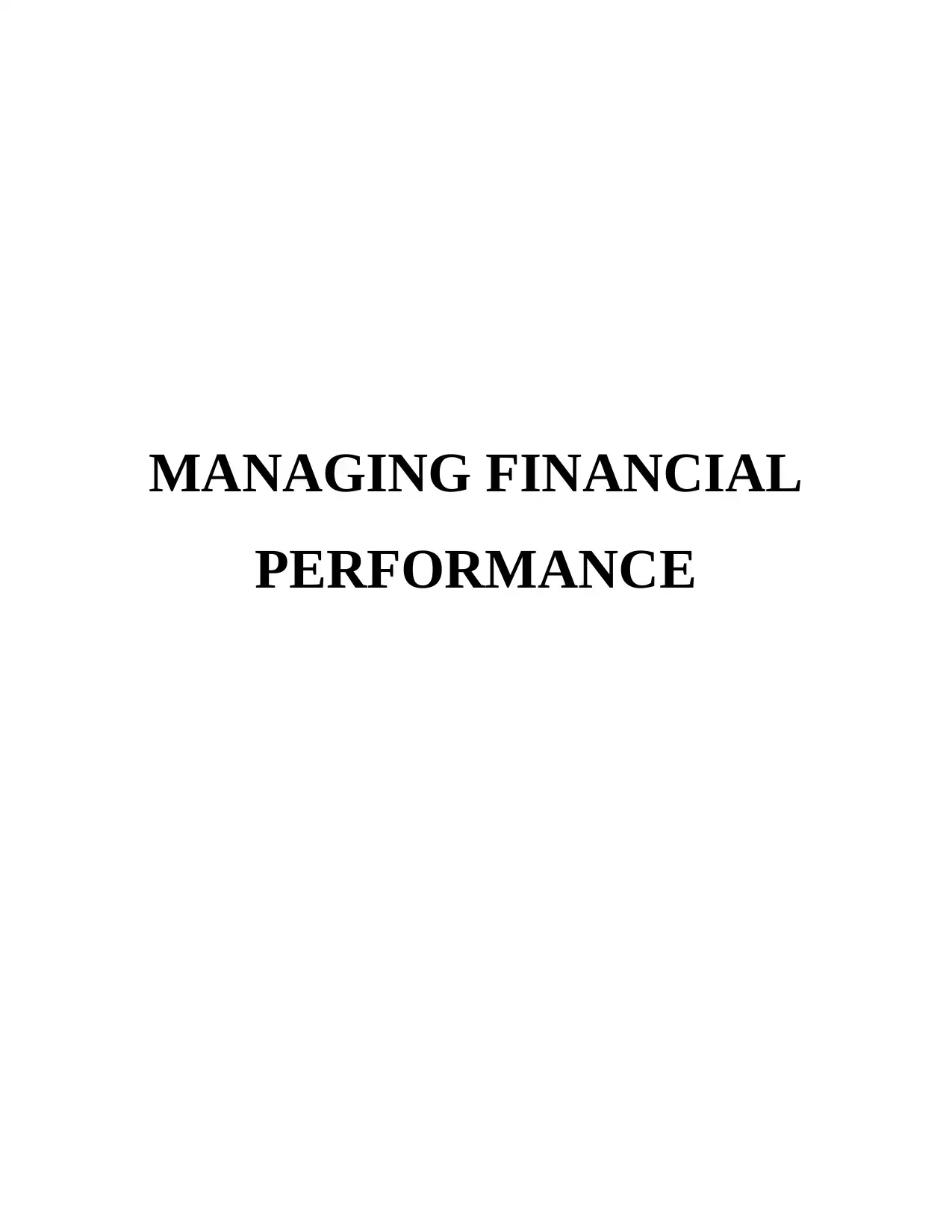
MANAGING FINANCIAL
PERFORMANCE
PERFORMANCE
Paraphrase This Document
Need a fresh take? Get an instant paraphrase of this document with our AI Paraphraser
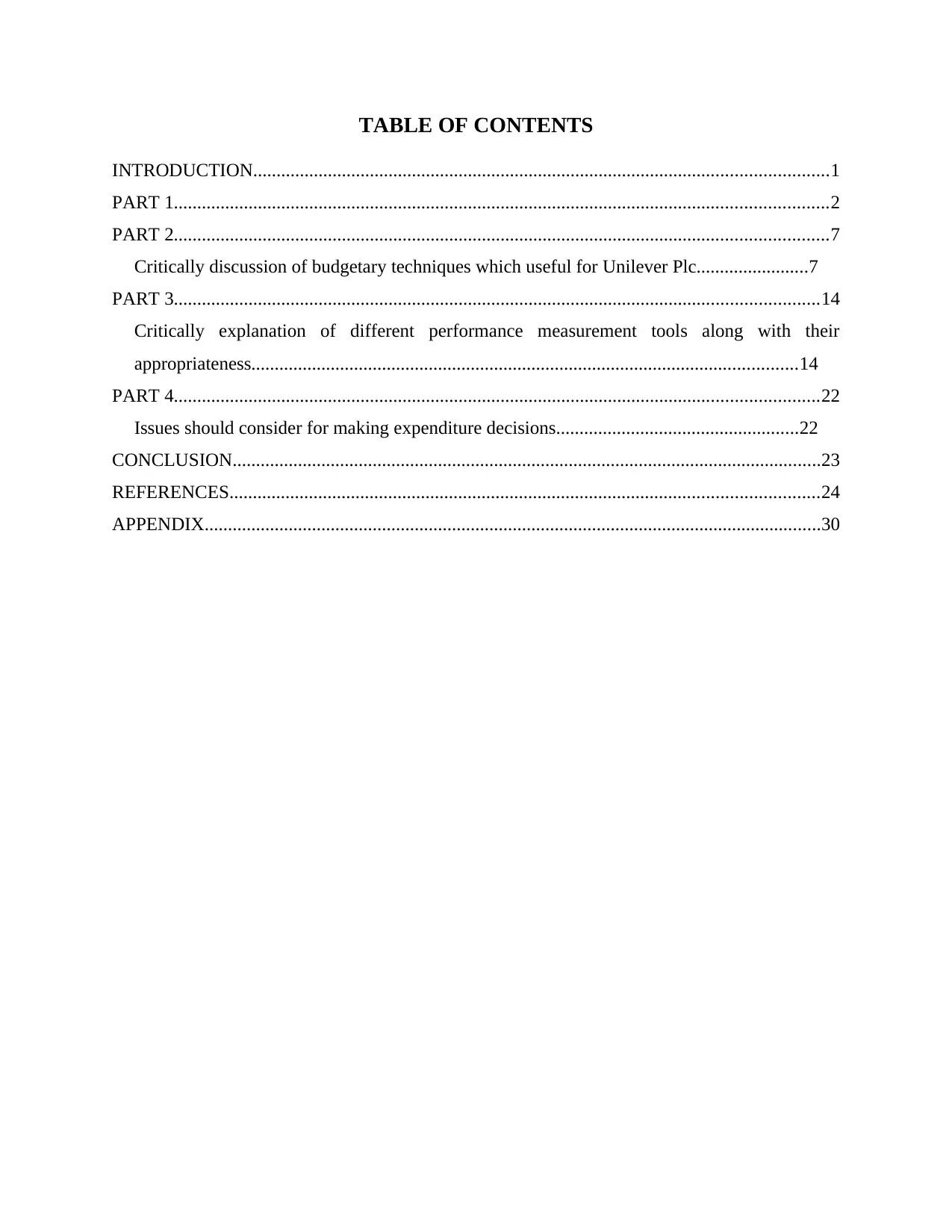
TABLE OF CONTENTS
INTRODUCTION...........................................................................................................................1
PART 1............................................................................................................................................2
PART 2............................................................................................................................................7
Critically discussion of budgetary techniques which useful for Unilever Plc........................7
PART 3..........................................................................................................................................14
Critically explanation of different performance measurement tools along with their
appropriateness.....................................................................................................................14
PART 4..........................................................................................................................................22
Issues should consider for making expenditure decisions....................................................22
CONCLUSION..............................................................................................................................23
REFERENCES..............................................................................................................................24
APPENDIX....................................................................................................................................30
INTRODUCTION...........................................................................................................................1
PART 1............................................................................................................................................2
PART 2............................................................................................................................................7
Critically discussion of budgetary techniques which useful for Unilever Plc........................7
PART 3..........................................................................................................................................14
Critically explanation of different performance measurement tools along with their
appropriateness.....................................................................................................................14
PART 4..........................................................................................................................................22
Issues should consider for making expenditure decisions....................................................22
CONCLUSION..............................................................................................................................23
REFERENCES..............................................................................................................................24
APPENDIX....................................................................................................................................30
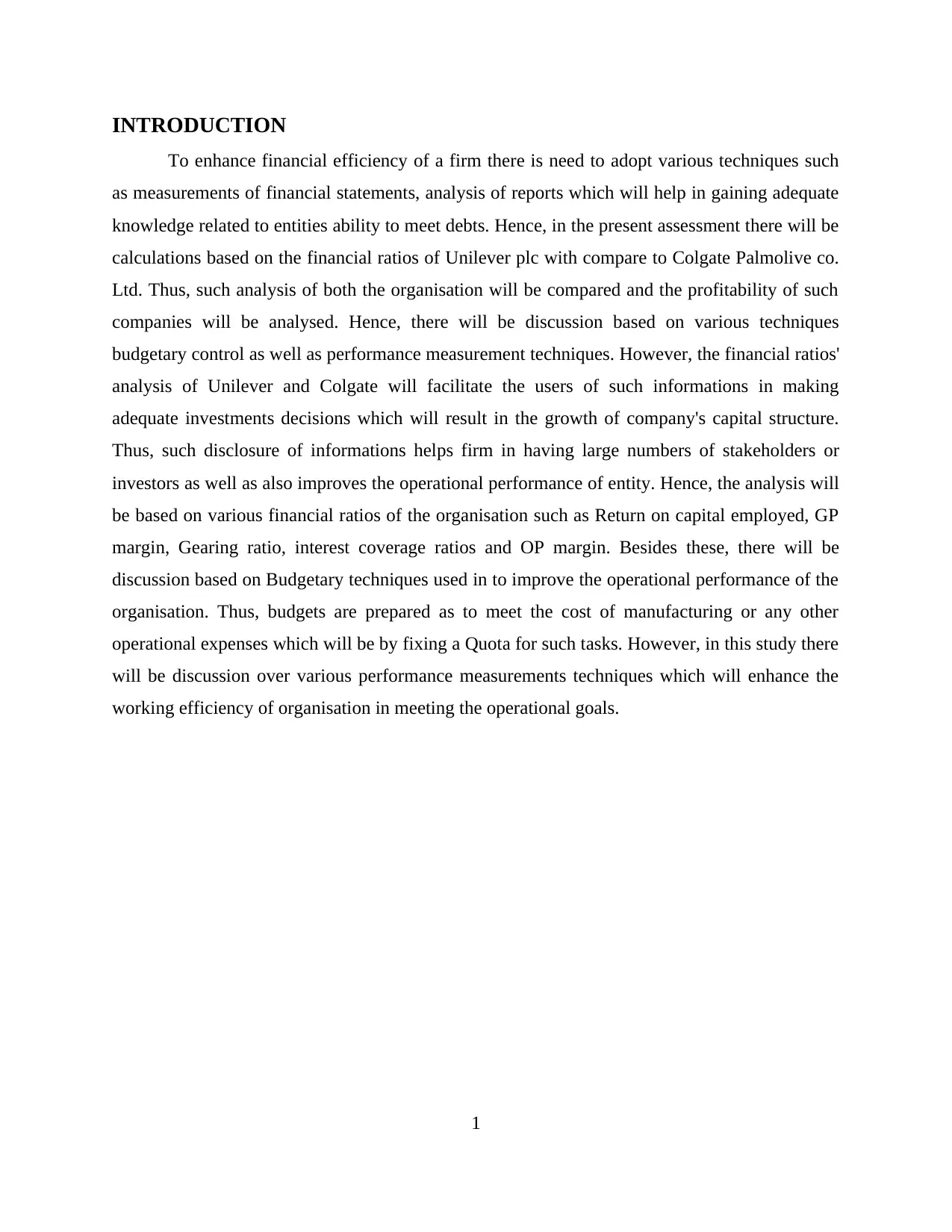
INTRODUCTION
To enhance financial efficiency of a firm there is need to adopt various techniques such
as measurements of financial statements, analysis of reports which will help in gaining adequate
knowledge related to entities ability to meet debts. Hence, in the present assessment there will be
calculations based on the financial ratios of Unilever plc with compare to Colgate Palmolive co.
Ltd. Thus, such analysis of both the organisation will be compared and the profitability of such
companies will be analysed. Hence, there will be discussion based on various techniques
budgetary control as well as performance measurement techniques. However, the financial ratios'
analysis of Unilever and Colgate will facilitate the users of such informations in making
adequate investments decisions which will result in the growth of company's capital structure.
Thus, such disclosure of informations helps firm in having large numbers of stakeholders or
investors as well as also improves the operational performance of entity. Hence, the analysis will
be based on various financial ratios of the organisation such as Return on capital employed, GP
margin, Gearing ratio, interest coverage ratios and OP margin. Besides these, there will be
discussion based on Budgetary techniques used in to improve the operational performance of the
organisation. Thus, budgets are prepared as to meet the cost of manufacturing or any other
operational expenses which will be by fixing a Quota for such tasks. However, in this study there
will be discussion over various performance measurements techniques which will enhance the
working efficiency of organisation in meeting the operational goals.
1
To enhance financial efficiency of a firm there is need to adopt various techniques such
as measurements of financial statements, analysis of reports which will help in gaining adequate
knowledge related to entities ability to meet debts. Hence, in the present assessment there will be
calculations based on the financial ratios of Unilever plc with compare to Colgate Palmolive co.
Ltd. Thus, such analysis of both the organisation will be compared and the profitability of such
companies will be analysed. Hence, there will be discussion based on various techniques
budgetary control as well as performance measurement techniques. However, the financial ratios'
analysis of Unilever and Colgate will facilitate the users of such informations in making
adequate investments decisions which will result in the growth of company's capital structure.
Thus, such disclosure of informations helps firm in having large numbers of stakeholders or
investors as well as also improves the operational performance of entity. Hence, the analysis will
be based on various financial ratios of the organisation such as Return on capital employed, GP
margin, Gearing ratio, interest coverage ratios and OP margin. Besides these, there will be
discussion based on Budgetary techniques used in to improve the operational performance of the
organisation. Thus, budgets are prepared as to meet the cost of manufacturing or any other
operational expenses which will be by fixing a Quota for such tasks. However, in this study there
will be discussion over various performance measurements techniques which will enhance the
working efficiency of organisation in meeting the operational goals.
1
⊘ This is a preview!⊘
Do you want full access?
Subscribe today to unlock all pages.

Trusted by 1+ million students worldwide
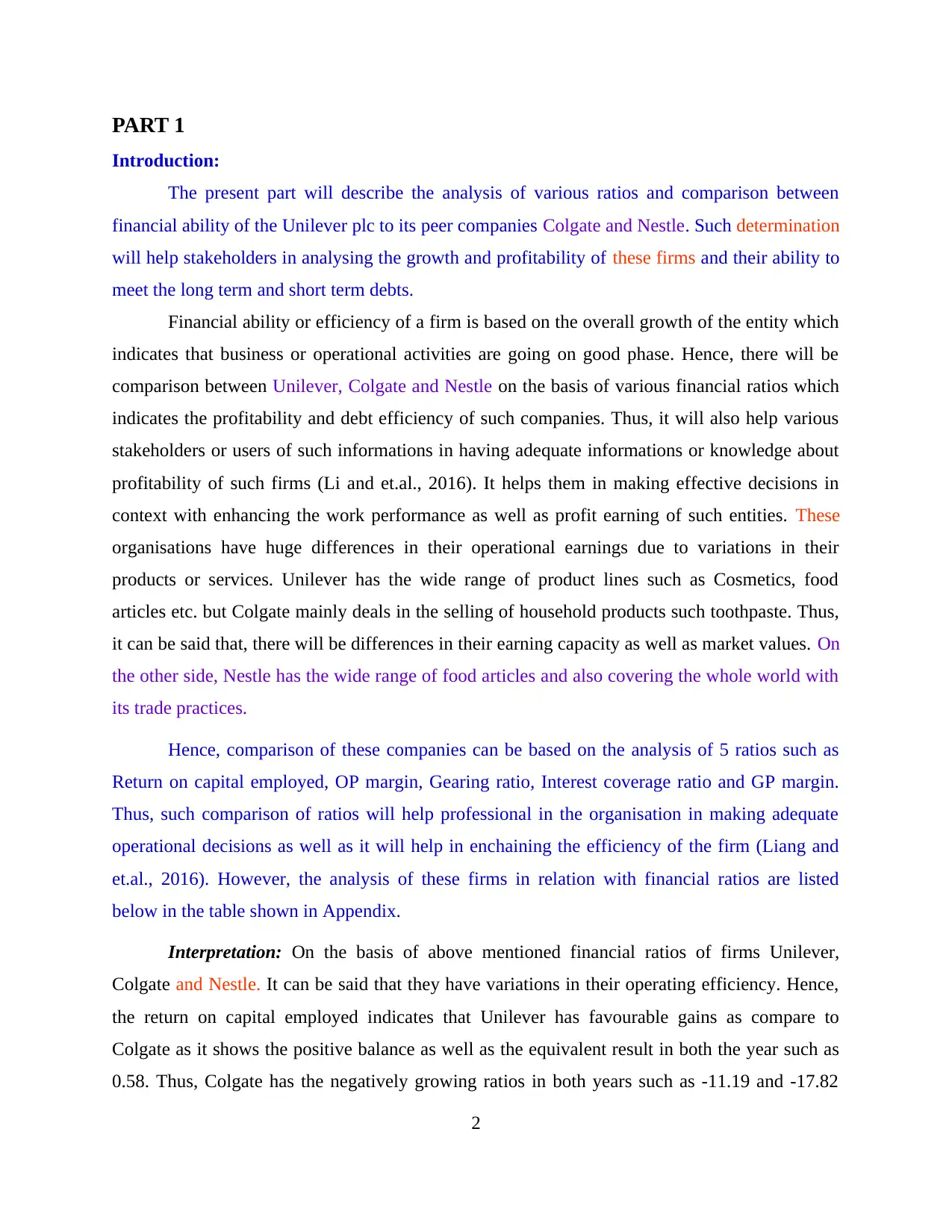
PART 1
Introduction:
The present part will describe the analysis of various ratios and comparison between
financial ability of the Unilever plc to its peer companies Colgate and Nestle. Such determination
will help stakeholders in analysing the growth and profitability of these firms and their ability to
meet the long term and short term debts.
Financial ability or efficiency of a firm is based on the overall growth of the entity which
indicates that business or operational activities are going on good phase. Hence, there will be
comparison between Unilever, Colgate and Nestle on the basis of various financial ratios which
indicates the profitability and debt efficiency of such companies. Thus, it will also help various
stakeholders or users of such informations in having adequate informations or knowledge about
profitability of such firms (Li and et.al., 2016). It helps them in making effective decisions in
context with enhancing the work performance as well as profit earning of such entities. These
organisations have huge differences in their operational earnings due to variations in their
products or services. Unilever has the wide range of product lines such as Cosmetics, food
articles etc. but Colgate mainly deals in the selling of household products such toothpaste. Thus,
it can be said that, there will be differences in their earning capacity as well as market values. On
the other side, Nestle has the wide range of food articles and also covering the whole world with
its trade practices.
Hence, comparison of these companies can be based on the analysis of 5 ratios such as
Return on capital employed, OP margin, Gearing ratio, Interest coverage ratio and GP margin.
Thus, such comparison of ratios will help professional in the organisation in making adequate
operational decisions as well as it will help in enchaining the efficiency of the firm (Liang and
et.al., 2016). However, the analysis of these firms in relation with financial ratios are listed
below in the table shown in Appendix.
Interpretation: On the basis of above mentioned financial ratios of firms Unilever,
Colgate and Nestle. It can be said that they have variations in their operating efficiency. Hence,
the return on capital employed indicates that Unilever has favourable gains as compare to
Colgate as it shows the positive balance as well as the equivalent result in both the year such as
0.58. Thus, Colgate has the negatively growing ratios in both years such as -11.19 and -17.82
2
Introduction:
The present part will describe the analysis of various ratios and comparison between
financial ability of the Unilever plc to its peer companies Colgate and Nestle. Such determination
will help stakeholders in analysing the growth and profitability of these firms and their ability to
meet the long term and short term debts.
Financial ability or efficiency of a firm is based on the overall growth of the entity which
indicates that business or operational activities are going on good phase. Hence, there will be
comparison between Unilever, Colgate and Nestle on the basis of various financial ratios which
indicates the profitability and debt efficiency of such companies. Thus, it will also help various
stakeholders or users of such informations in having adequate informations or knowledge about
profitability of such firms (Li and et.al., 2016). It helps them in making effective decisions in
context with enhancing the work performance as well as profit earning of such entities. These
organisations have huge differences in their operational earnings due to variations in their
products or services. Unilever has the wide range of product lines such as Cosmetics, food
articles etc. but Colgate mainly deals in the selling of household products such toothpaste. Thus,
it can be said that, there will be differences in their earning capacity as well as market values. On
the other side, Nestle has the wide range of food articles and also covering the whole world with
its trade practices.
Hence, comparison of these companies can be based on the analysis of 5 ratios such as
Return on capital employed, OP margin, Gearing ratio, Interest coverage ratio and GP margin.
Thus, such comparison of ratios will help professional in the organisation in making adequate
operational decisions as well as it will help in enchaining the efficiency of the firm (Liang and
et.al., 2016). However, the analysis of these firms in relation with financial ratios are listed
below in the table shown in Appendix.
Interpretation: On the basis of above mentioned financial ratios of firms Unilever,
Colgate and Nestle. It can be said that they have variations in their operating efficiency. Hence,
the return on capital employed indicates that Unilever has favourable gains as compare to
Colgate as it shows the positive balance as well as the equivalent result in both the year such as
0.58. Thus, Colgate has the negatively growing ratios in both years such as -11.19 and -17.82
2
Paraphrase This Document
Need a fresh take? Get an instant paraphrase of this document with our AI Paraphraser
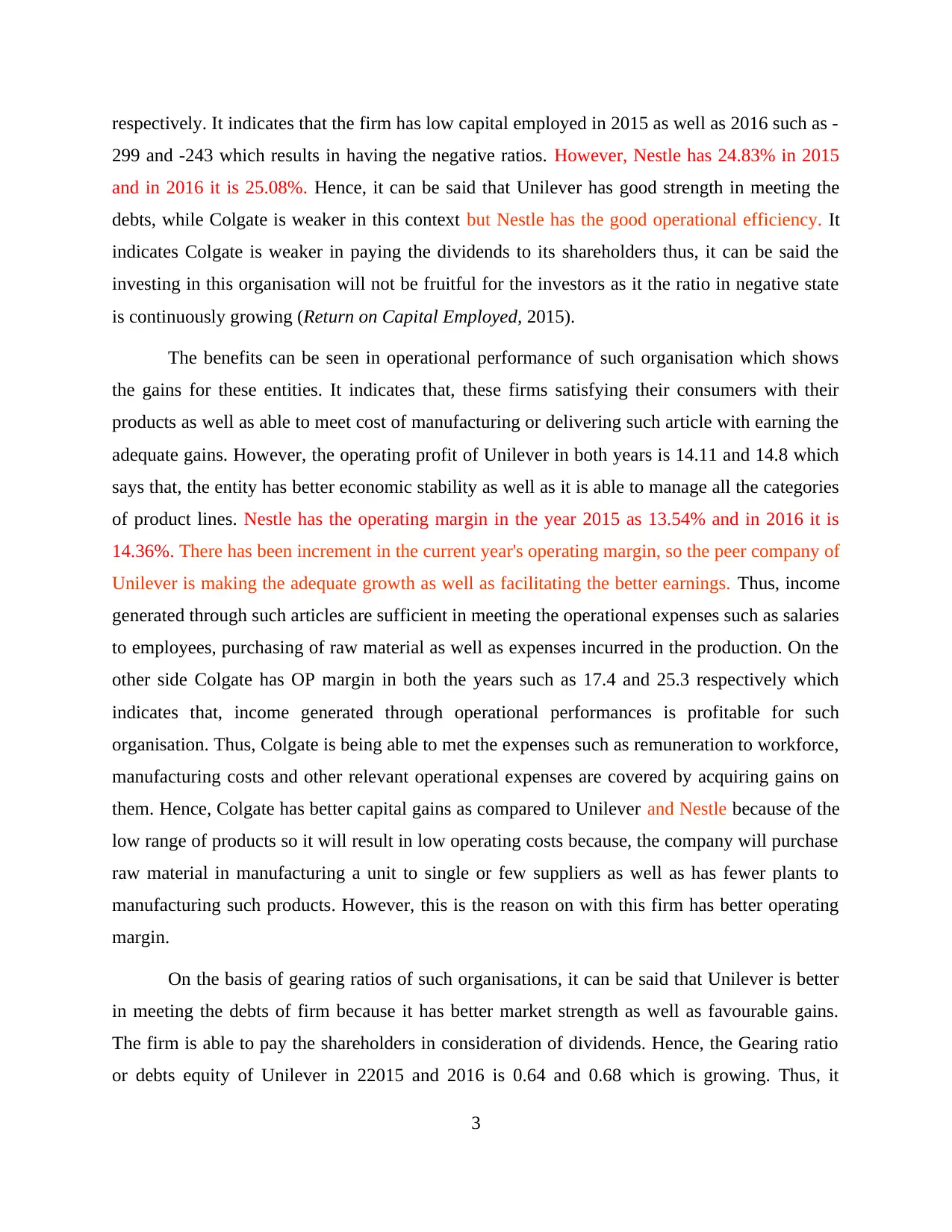
respectively. It indicates that the firm has low capital employed in 2015 as well as 2016 such as -
299 and -243 which results in having the negative ratios. However, Nestle has 24.83% in 2015
and in 2016 it is 25.08%. Hence, it can be said that Unilever has good strength in meeting the
debts, while Colgate is weaker in this context but Nestle has the good operational efficiency. It
indicates Colgate is weaker in paying the dividends to its shareholders thus, it can be said the
investing in this organisation will not be fruitful for the investors as it the ratio in negative state
is continuously growing (Return on Capital Employed, 2015).
The benefits can be seen in operational performance of such organisation which shows
the gains for these entities. It indicates that, these firms satisfying their consumers with their
products as well as able to meet cost of manufacturing or delivering such article with earning the
adequate gains. However, the operating profit of Unilever in both years is 14.11 and 14.8 which
says that, the entity has better economic stability as well as it is able to manage all the categories
of product lines. Nestle has the operating margin in the year 2015 as 13.54% and in 2016 it is
14.36%. There has been increment in the current year's operating margin, so the peer company of
Unilever is making the adequate growth as well as facilitating the better earnings. Thus, income
generated through such articles are sufficient in meeting the operational expenses such as salaries
to employees, purchasing of raw material as well as expenses incurred in the production. On the
other side Colgate has OP margin in both the years such as 17.4 and 25.3 respectively which
indicates that, income generated through operational performances is profitable for such
organisation. Thus, Colgate is being able to met the expenses such as remuneration to workforce,
manufacturing costs and other relevant operational expenses are covered by acquiring gains on
them. Hence, Colgate has better capital gains as compared to Unilever and Nestle because of the
low range of products so it will result in low operating costs because, the company will purchase
raw material in manufacturing a unit to single or few suppliers as well as has fewer plants to
manufacturing such products. However, this is the reason on with this firm has better operating
margin.
On the basis of gearing ratios of such organisations, it can be said that Unilever is better
in meeting the debts of firm because it has better market strength as well as favourable gains.
The firm is able to pay the shareholders in consideration of dividends. Hence, the Gearing ratio
or debts equity of Unilever in 22015 and 2016 is 0.64 and 0.68 which is growing. Thus, it
3
299 and -243 which results in having the negative ratios. However, Nestle has 24.83% in 2015
and in 2016 it is 25.08%. Hence, it can be said that Unilever has good strength in meeting the
debts, while Colgate is weaker in this context but Nestle has the good operational efficiency. It
indicates Colgate is weaker in paying the dividends to its shareholders thus, it can be said the
investing in this organisation will not be fruitful for the investors as it the ratio in negative state
is continuously growing (Return on Capital Employed, 2015).
The benefits can be seen in operational performance of such organisation which shows
the gains for these entities. It indicates that, these firms satisfying their consumers with their
products as well as able to meet cost of manufacturing or delivering such article with earning the
adequate gains. However, the operating profit of Unilever in both years is 14.11 and 14.8 which
says that, the entity has better economic stability as well as it is able to manage all the categories
of product lines. Nestle has the operating margin in the year 2015 as 13.54% and in 2016 it is
14.36%. There has been increment in the current year's operating margin, so the peer company of
Unilever is making the adequate growth as well as facilitating the better earnings. Thus, income
generated through such articles are sufficient in meeting the operational expenses such as salaries
to employees, purchasing of raw material as well as expenses incurred in the production. On the
other side Colgate has OP margin in both the years such as 17.4 and 25.3 respectively which
indicates that, income generated through operational performances is profitable for such
organisation. Thus, Colgate is being able to met the expenses such as remuneration to workforce,
manufacturing costs and other relevant operational expenses are covered by acquiring gains on
them. Hence, Colgate has better capital gains as compared to Unilever and Nestle because of the
low range of products so it will result in low operating costs because, the company will purchase
raw material in manufacturing a unit to single or few suppliers as well as has fewer plants to
manufacturing such products. However, this is the reason on with this firm has better operating
margin.
On the basis of gearing ratios of such organisations, it can be said that Unilever is better
in meeting the debts of firm because it has better market strength as well as favourable gains.
The firm is able to pay the shareholders in consideration of dividends. Hence, the Gearing ratio
or debts equity of Unilever in 22015 and 2016 is 0.64 and 0.68 which is growing. Thus, it
3
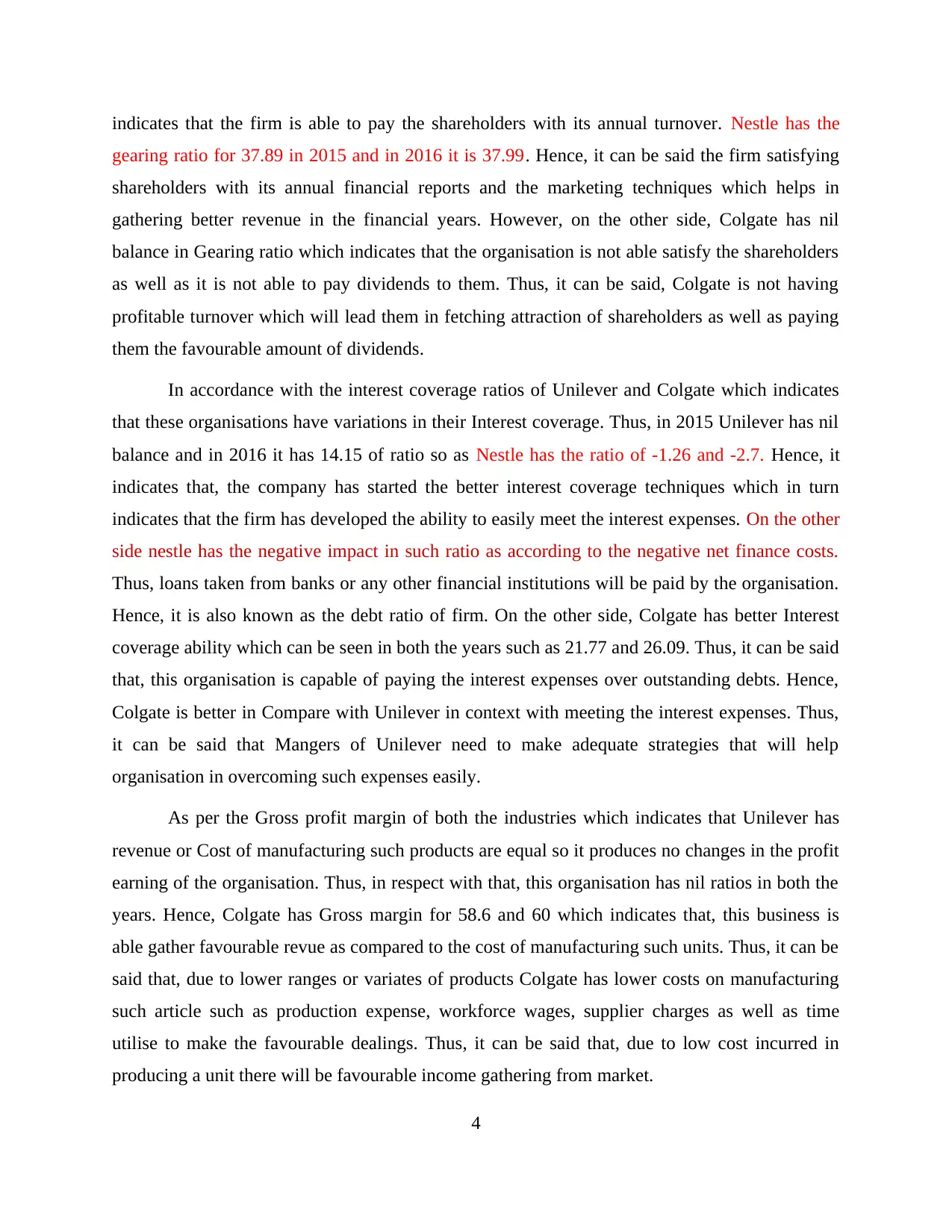
indicates that the firm is able to pay the shareholders with its annual turnover. Nestle has the
gearing ratio for 37.89 in 2015 and in 2016 it is 37.99. Hence, it can be said the firm satisfying
shareholders with its annual financial reports and the marketing techniques which helps in
gathering better revenue in the financial years. However, on the other side, Colgate has nil
balance in Gearing ratio which indicates that the organisation is not able satisfy the shareholders
as well as it is not able to pay dividends to them. Thus, it can be said, Colgate is not having
profitable turnover which will lead them in fetching attraction of shareholders as well as paying
them the favourable amount of dividends.
In accordance with the interest coverage ratios of Unilever and Colgate which indicates
that these organisations have variations in their Interest coverage. Thus, in 2015 Unilever has nil
balance and in 2016 it has 14.15 of ratio so as Nestle has the ratio of -1.26 and -2.7. Hence, it
indicates that, the company has started the better interest coverage techniques which in turn
indicates that the firm has developed the ability to easily meet the interest expenses. On the other
side nestle has the negative impact in such ratio as according to the negative net finance costs.
Thus, loans taken from banks or any other financial institutions will be paid by the organisation.
Hence, it is also known as the debt ratio of firm. On the other side, Colgate has better Interest
coverage ability which can be seen in both the years such as 21.77 and 26.09. Thus, it can be said
that, this organisation is capable of paying the interest expenses over outstanding debts. Hence,
Colgate is better in Compare with Unilever in context with meeting the interest expenses. Thus,
it can be said that Mangers of Unilever need to make adequate strategies that will help
organisation in overcoming such expenses easily.
As per the Gross profit margin of both the industries which indicates that Unilever has
revenue or Cost of manufacturing such products are equal so it produces no changes in the profit
earning of the organisation. Thus, in respect with that, this organisation has nil ratios in both the
years. Hence, Colgate has Gross margin for 58.6 and 60 which indicates that, this business is
able gather favourable revue as compared to the cost of manufacturing such units. Thus, it can be
said that, due to lower ranges or variates of products Colgate has lower costs on manufacturing
such article such as production expense, workforce wages, supplier charges as well as time
utilise to make the favourable dealings. Thus, it can be said that, due to low cost incurred in
producing a unit there will be favourable income gathering from market.
4
gearing ratio for 37.89 in 2015 and in 2016 it is 37.99. Hence, it can be said the firm satisfying
shareholders with its annual financial reports and the marketing techniques which helps in
gathering better revenue in the financial years. However, on the other side, Colgate has nil
balance in Gearing ratio which indicates that the organisation is not able satisfy the shareholders
as well as it is not able to pay dividends to them. Thus, it can be said, Colgate is not having
profitable turnover which will lead them in fetching attraction of shareholders as well as paying
them the favourable amount of dividends.
In accordance with the interest coverage ratios of Unilever and Colgate which indicates
that these organisations have variations in their Interest coverage. Thus, in 2015 Unilever has nil
balance and in 2016 it has 14.15 of ratio so as Nestle has the ratio of -1.26 and -2.7. Hence, it
indicates that, the company has started the better interest coverage techniques which in turn
indicates that the firm has developed the ability to easily meet the interest expenses. On the other
side nestle has the negative impact in such ratio as according to the negative net finance costs.
Thus, loans taken from banks or any other financial institutions will be paid by the organisation.
Hence, it is also known as the debt ratio of firm. On the other side, Colgate has better Interest
coverage ability which can be seen in both the years such as 21.77 and 26.09. Thus, it can be said
that, this organisation is capable of paying the interest expenses over outstanding debts. Hence,
Colgate is better in Compare with Unilever in context with meeting the interest expenses. Thus,
it can be said that Mangers of Unilever need to make adequate strategies that will help
organisation in overcoming such expenses easily.
As per the Gross profit margin of both the industries which indicates that Unilever has
revenue or Cost of manufacturing such products are equal so it produces no changes in the profit
earning of the organisation. Thus, in respect with that, this organisation has nil ratios in both the
years. Hence, Colgate has Gross margin for 58.6 and 60 which indicates that, this business is
able gather favourable revue as compared to the cost of manufacturing such units. Thus, it can be
said that, due to lower ranges or variates of products Colgate has lower costs on manufacturing
such article such as production expense, workforce wages, supplier charges as well as time
utilise to make the favourable dealings. Thus, it can be said that, due to low cost incurred in
producing a unit there will be favourable income gathering from market.
4
⊘ This is a preview!⊘
Do you want full access?
Subscribe today to unlock all pages.

Trusted by 1+ million students worldwide
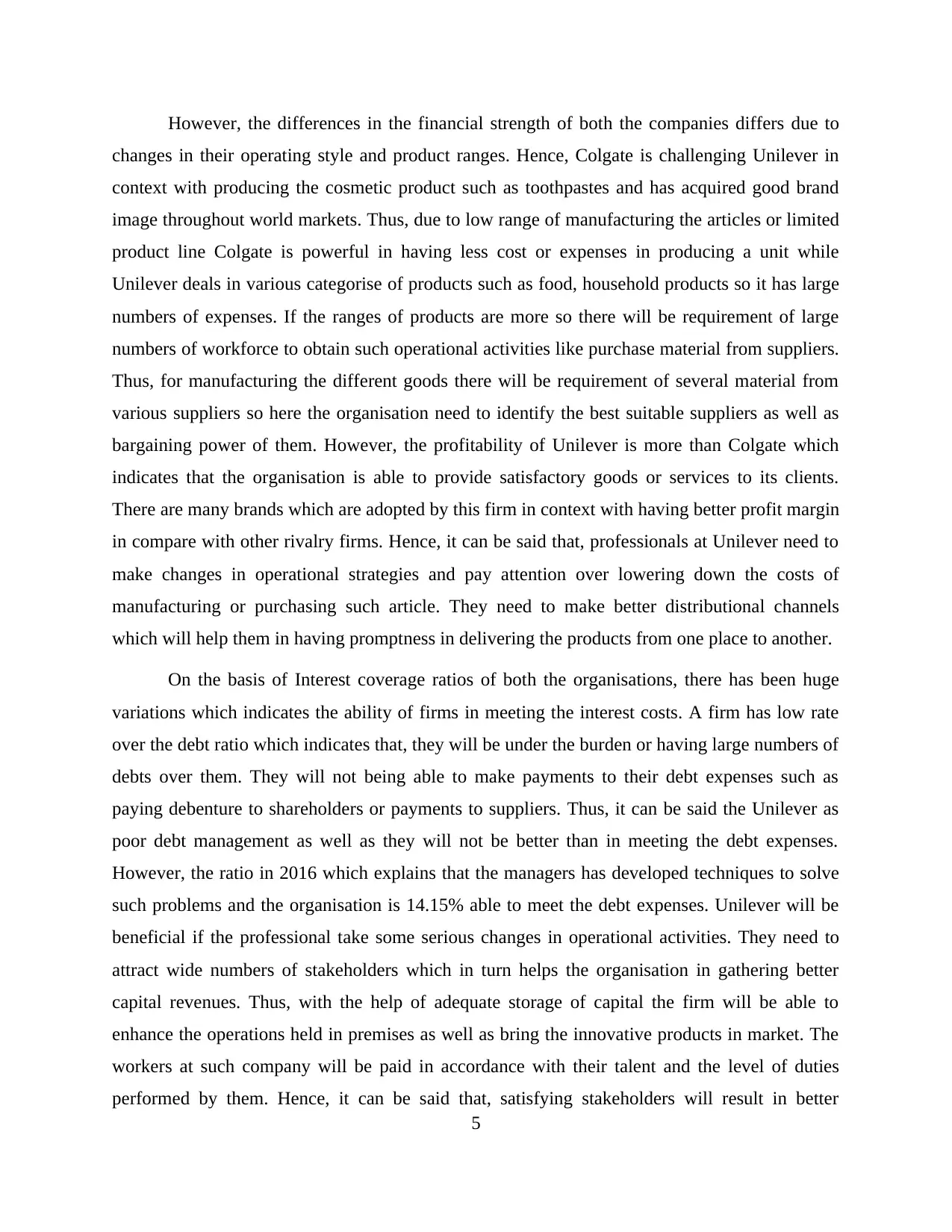
However, the differences in the financial strength of both the companies differs due to
changes in their operating style and product ranges. Hence, Colgate is challenging Unilever in
context with producing the cosmetic product such as toothpastes and has acquired good brand
image throughout world markets. Thus, due to low range of manufacturing the articles or limited
product line Colgate is powerful in having less cost or expenses in producing a unit while
Unilever deals in various categorise of products such as food, household products so it has large
numbers of expenses. If the ranges of products are more so there will be requirement of large
numbers of workforce to obtain such operational activities like purchase material from suppliers.
Thus, for manufacturing the different goods there will be requirement of several material from
various suppliers so here the organisation need to identify the best suitable suppliers as well as
bargaining power of them. However, the profitability of Unilever is more than Colgate which
indicates that the organisation is able to provide satisfactory goods or services to its clients.
There are many brands which are adopted by this firm in context with having better profit margin
in compare with other rivalry firms. Hence, it can be said that, professionals at Unilever need to
make changes in operational strategies and pay attention over lowering down the costs of
manufacturing or purchasing such article. They need to make better distributional channels
which will help them in having promptness in delivering the products from one place to another.
On the basis of Interest coverage ratios of both the organisations, there has been huge
variations which indicates the ability of firms in meeting the interest costs. A firm has low rate
over the debt ratio which indicates that, they will be under the burden or having large numbers of
debts over them. They will not being able to make payments to their debt expenses such as
paying debenture to shareholders or payments to suppliers. Thus, it can be said the Unilever as
poor debt management as well as they will not be better than in meeting the debt expenses.
However, the ratio in 2016 which explains that the managers has developed techniques to solve
such problems and the organisation is 14.15% able to meet the debt expenses. Unilever will be
beneficial if the professional take some serious changes in operational activities. They need to
attract wide numbers of stakeholders which in turn helps the organisation in gathering better
capital revenues. Thus, with the help of adequate storage of capital the firm will be able to
enhance the operations held in premises as well as bring the innovative products in market. The
workers at such company will be paid in accordance with their talent and the level of duties
performed by them. Hence, it can be said that, satisfying stakeholders will result in better
5
changes in their operating style and product ranges. Hence, Colgate is challenging Unilever in
context with producing the cosmetic product such as toothpastes and has acquired good brand
image throughout world markets. Thus, due to low range of manufacturing the articles or limited
product line Colgate is powerful in having less cost or expenses in producing a unit while
Unilever deals in various categorise of products such as food, household products so it has large
numbers of expenses. If the ranges of products are more so there will be requirement of large
numbers of workforce to obtain such operational activities like purchase material from suppliers.
Thus, for manufacturing the different goods there will be requirement of several material from
various suppliers so here the organisation need to identify the best suitable suppliers as well as
bargaining power of them. However, the profitability of Unilever is more than Colgate which
indicates that the organisation is able to provide satisfactory goods or services to its clients.
There are many brands which are adopted by this firm in context with having better profit margin
in compare with other rivalry firms. Hence, it can be said that, professionals at Unilever need to
make changes in operational strategies and pay attention over lowering down the costs of
manufacturing or purchasing such article. They need to make better distributional channels
which will help them in having promptness in delivering the products from one place to another.
On the basis of Interest coverage ratios of both the organisations, there has been huge
variations which indicates the ability of firms in meeting the interest costs. A firm has low rate
over the debt ratio which indicates that, they will be under the burden or having large numbers of
debts over them. They will not being able to make payments to their debt expenses such as
paying debenture to shareholders or payments to suppliers. Thus, it can be said the Unilever as
poor debt management as well as they will not be better than in meeting the debt expenses.
However, the ratio in 2016 which explains that the managers has developed techniques to solve
such problems and the organisation is 14.15% able to meet the debt expenses. Unilever will be
beneficial if the professional take some serious changes in operational activities. They need to
attract wide numbers of stakeholders which in turn helps the organisation in gathering better
capital revenues. Thus, with the help of adequate storage of capital the firm will be able to
enhance the operations held in premises as well as bring the innovative products in market. The
workers at such company will be paid in accordance with their talent and the level of duties
performed by them. Hence, it can be said that, satisfying stakeholders will result in better
5
Paraphrase This Document
Need a fresh take? Get an instant paraphrase of this document with our AI Paraphraser
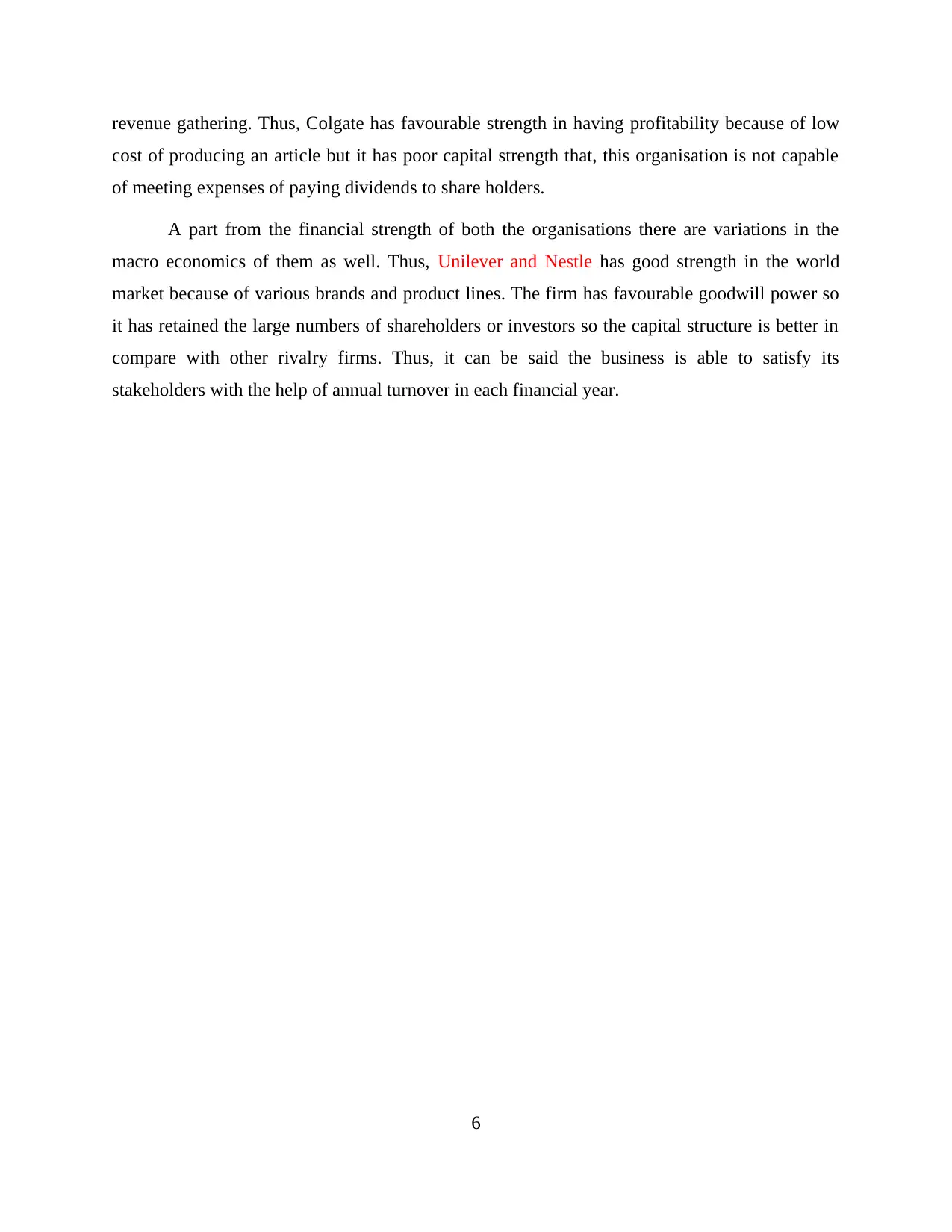
revenue gathering. Thus, Colgate has favourable strength in having profitability because of low
cost of producing an article but it has poor capital strength that, this organisation is not capable
of meeting expenses of paying dividends to share holders.
A part from the financial strength of both the organisations there are variations in the
macro economics of them as well. Thus, Unilever and Nestle has good strength in the world
market because of various brands and product lines. The firm has favourable goodwill power so
it has retained the large numbers of shareholders or investors so the capital structure is better in
compare with other rivalry firms. Thus, it can be said the business is able to satisfy its
stakeholders with the help of annual turnover in each financial year.
6
cost of producing an article but it has poor capital strength that, this organisation is not capable
of meeting expenses of paying dividends to share holders.
A part from the financial strength of both the organisations there are variations in the
macro economics of them as well. Thus, Unilever and Nestle has good strength in the world
market because of various brands and product lines. The firm has favourable goodwill power so
it has retained the large numbers of shareholders or investors so the capital structure is better in
compare with other rivalry firms. Thus, it can be said the business is able to satisfy its
stakeholders with the help of annual turnover in each financial year.
6
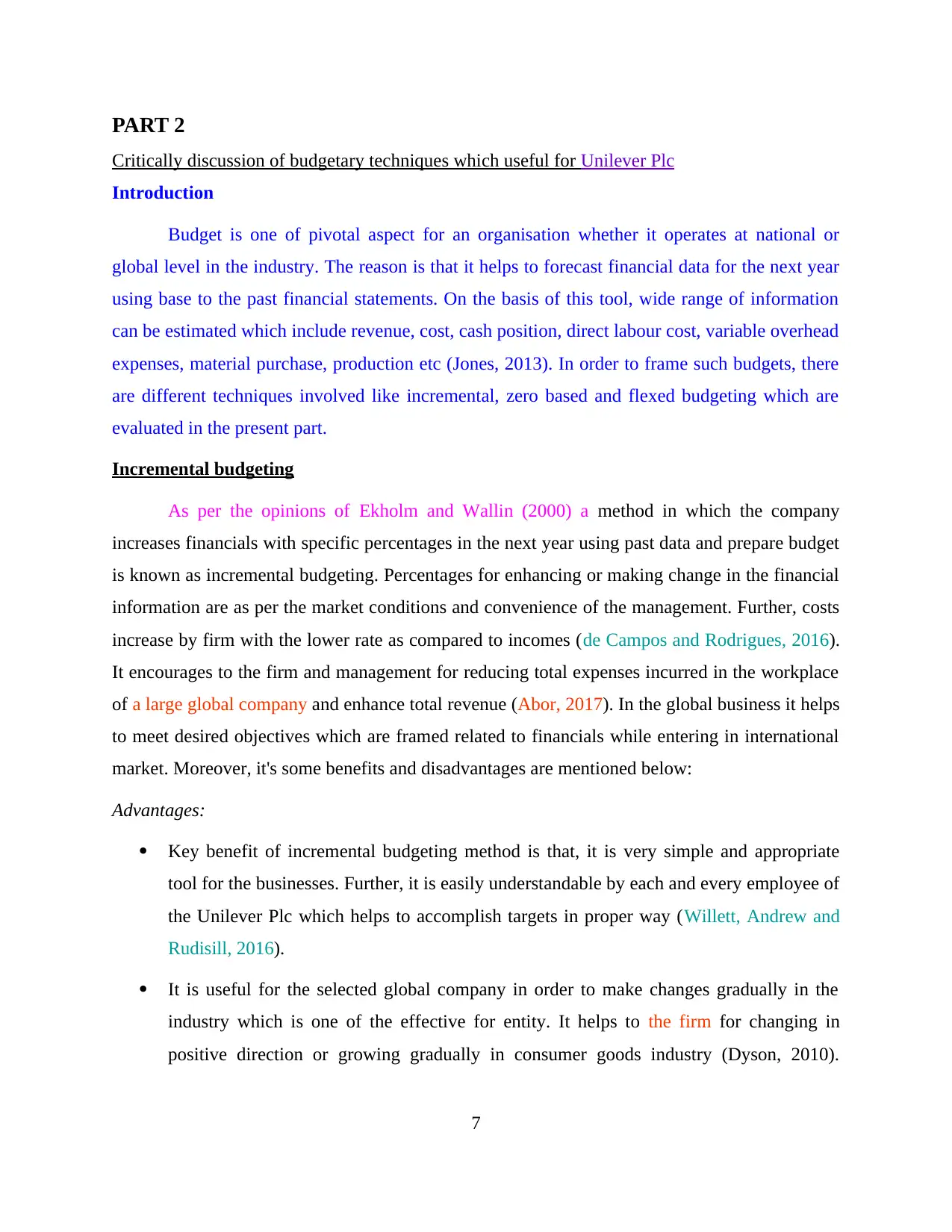
PART 2
Critically discussion of budgetary techniques which useful for Unilever Plc
Introduction
Budget is one of pivotal aspect for an organisation whether it operates at national or
global level in the industry. The reason is that it helps to forecast financial data for the next year
using base to the past financial statements. On the basis of this tool, wide range of information
can be estimated which include revenue, cost, cash position, direct labour cost, variable overhead
expenses, material purchase, production etc (Jones, 2013). In order to frame such budgets, there
are different techniques involved like incremental, zero based and flexed budgeting which are
evaluated in the present part.
Incremental budgeting
As per the opinions of Ekholm and Wallin (2000) a method in which the company
increases financials with specific percentages in the next year using past data and prepare budget
is known as incremental budgeting. Percentages for enhancing or making change in the financial
information are as per the market conditions and convenience of the management. Further, costs
increase by firm with the lower rate as compared to incomes (de Campos and Rodrigues, 2016).
It encourages to the firm and management for reducing total expenses incurred in the workplace
of a large global company and enhance total revenue (Abor, 2017). In the global business it helps
to meet desired objectives which are framed related to financials while entering in international
market. Moreover, it's some benefits and disadvantages are mentioned below:
Advantages:
Key benefit of incremental budgeting method is that, it is very simple and appropriate
tool for the businesses. Further, it is easily understandable by each and every employee of
the Unilever Plc which helps to accomplish targets in proper way (Willett, Andrew and
Rudisill, 2016).
It is useful for the selected global company in order to make changes gradually in the
industry which is one of the effective for entity. It helps to the firm for changing in
positive direction or growing gradually in consumer goods industry (Dyson, 2010).
7
Critically discussion of budgetary techniques which useful for Unilever Plc
Introduction
Budget is one of pivotal aspect for an organisation whether it operates at national or
global level in the industry. The reason is that it helps to forecast financial data for the next year
using base to the past financial statements. On the basis of this tool, wide range of information
can be estimated which include revenue, cost, cash position, direct labour cost, variable overhead
expenses, material purchase, production etc (Jones, 2013). In order to frame such budgets, there
are different techniques involved like incremental, zero based and flexed budgeting which are
evaluated in the present part.
Incremental budgeting
As per the opinions of Ekholm and Wallin (2000) a method in which the company
increases financials with specific percentages in the next year using past data and prepare budget
is known as incremental budgeting. Percentages for enhancing or making change in the financial
information are as per the market conditions and convenience of the management. Further, costs
increase by firm with the lower rate as compared to incomes (de Campos and Rodrigues, 2016).
It encourages to the firm and management for reducing total expenses incurred in the workplace
of a large global company and enhance total revenue (Abor, 2017). In the global business it helps
to meet desired objectives which are framed related to financials while entering in international
market. Moreover, it's some benefits and disadvantages are mentioned below:
Advantages:
Key benefit of incremental budgeting method is that, it is very simple and appropriate
tool for the businesses. Further, it is easily understandable by each and every employee of
the Unilever Plc which helps to accomplish targets in proper way (Willett, Andrew and
Rudisill, 2016).
It is useful for the selected global company in order to make changes gradually in the
industry which is one of the effective for entity. It helps to the firm for changing in
positive direction or growing gradually in consumer goods industry (Dyson, 2010).
7
⊘ This is a preview!⊘
Do you want full access?
Subscribe today to unlock all pages.

Trusted by 1+ million students worldwide
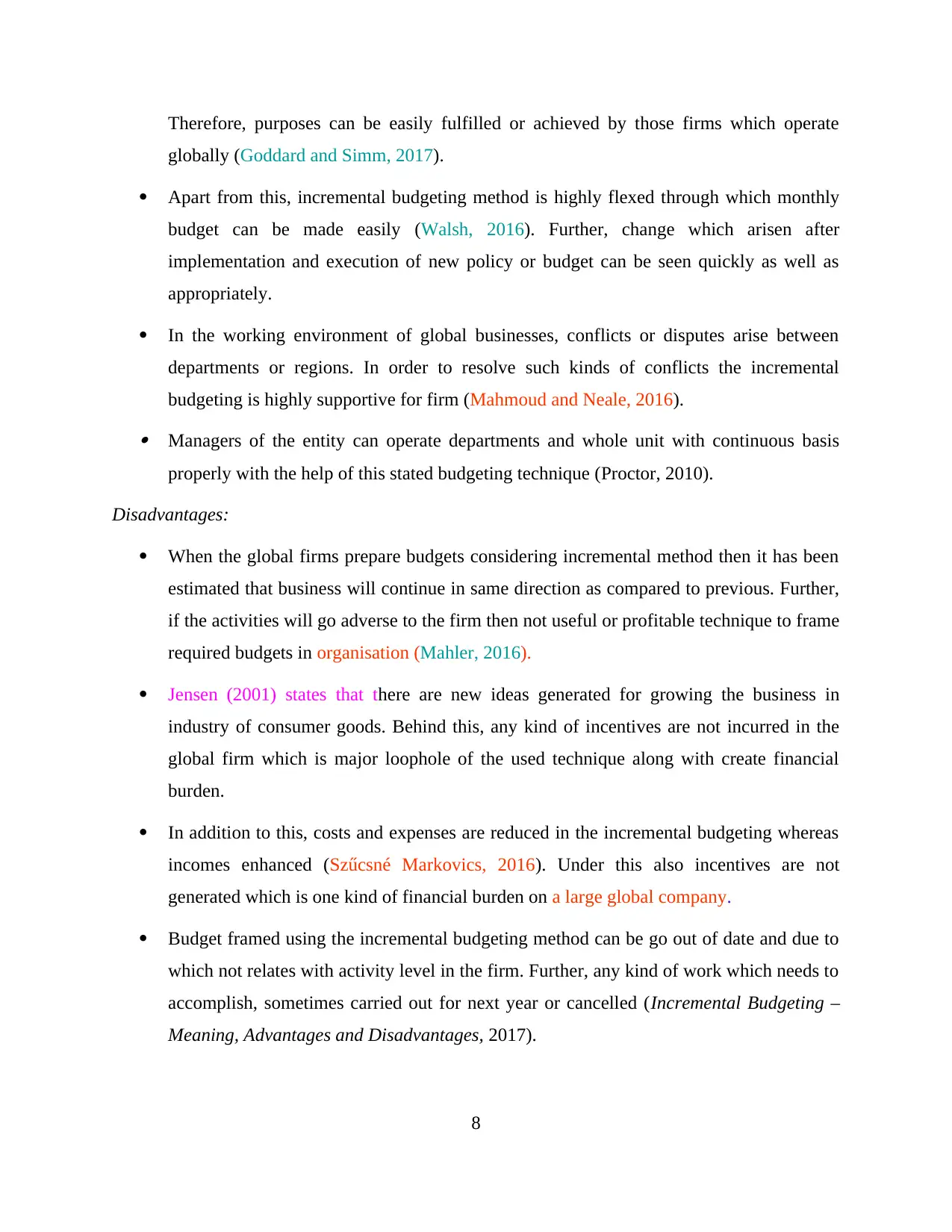
Therefore, purposes can be easily fulfilled or achieved by those firms which operate
globally (Goddard and Simm, 2017).
Apart from this, incremental budgeting method is highly flexed through which monthly
budget can be made easily (Walsh, 2016). Further, change which arisen after
implementation and execution of new policy or budget can be seen quickly as well as
appropriately.
In the working environment of global businesses, conflicts or disputes arise between
departments or regions. In order to resolve such kinds of conflicts the incremental
budgeting is highly supportive for firm (Mahmoud and Neale, 2016). Managers of the entity can operate departments and whole unit with continuous basis
properly with the help of this stated budgeting technique (Proctor, 2010).
Disadvantages:
When the global firms prepare budgets considering incremental method then it has been
estimated that business will continue in same direction as compared to previous. Further,
if the activities will go adverse to the firm then not useful or profitable technique to frame
required budgets in organisation (Mahler, 2016).
Jensen (2001) states that there are new ideas generated for growing the business in
industry of consumer goods. Behind this, any kind of incentives are not incurred in the
global firm which is major loophole of the used technique along with create financial
burden.
In addition to this, costs and expenses are reduced in the incremental budgeting whereas
incomes enhanced (Szűcsné Markovics, 2016). Under this also incentives are not
generated which is one kind of financial burden on a large global company.
Budget framed using the incremental budgeting method can be go out of date and due to
which not relates with activity level in the firm. Further, any kind of work which needs to
accomplish, sometimes carried out for next year or cancelled (Incremental Budgeting –
Meaning, Advantages and Disadvantages, 2017).
8
globally (Goddard and Simm, 2017).
Apart from this, incremental budgeting method is highly flexed through which monthly
budget can be made easily (Walsh, 2016). Further, change which arisen after
implementation and execution of new policy or budget can be seen quickly as well as
appropriately.
In the working environment of global businesses, conflicts or disputes arise between
departments or regions. In order to resolve such kinds of conflicts the incremental
budgeting is highly supportive for firm (Mahmoud and Neale, 2016). Managers of the entity can operate departments and whole unit with continuous basis
properly with the help of this stated budgeting technique (Proctor, 2010).
Disadvantages:
When the global firms prepare budgets considering incremental method then it has been
estimated that business will continue in same direction as compared to previous. Further,
if the activities will go adverse to the firm then not useful or profitable technique to frame
required budgets in organisation (Mahler, 2016).
Jensen (2001) states that there are new ideas generated for growing the business in
industry of consumer goods. Behind this, any kind of incentives are not incurred in the
global firm which is major loophole of the used technique along with create financial
burden.
In addition to this, costs and expenses are reduced in the incremental budgeting whereas
incomes enhanced (Szűcsné Markovics, 2016). Under this also incentives are not
generated which is one kind of financial burden on a large global company.
Budget framed using the incremental budgeting method can be go out of date and due to
which not relates with activity level in the firm. Further, any kind of work which needs to
accomplish, sometimes carried out for next year or cancelled (Incremental Budgeting –
Meaning, Advantages and Disadvantages, 2017).
8
Paraphrase This Document
Need a fresh take? Get an instant paraphrase of this document with our AI Paraphraser
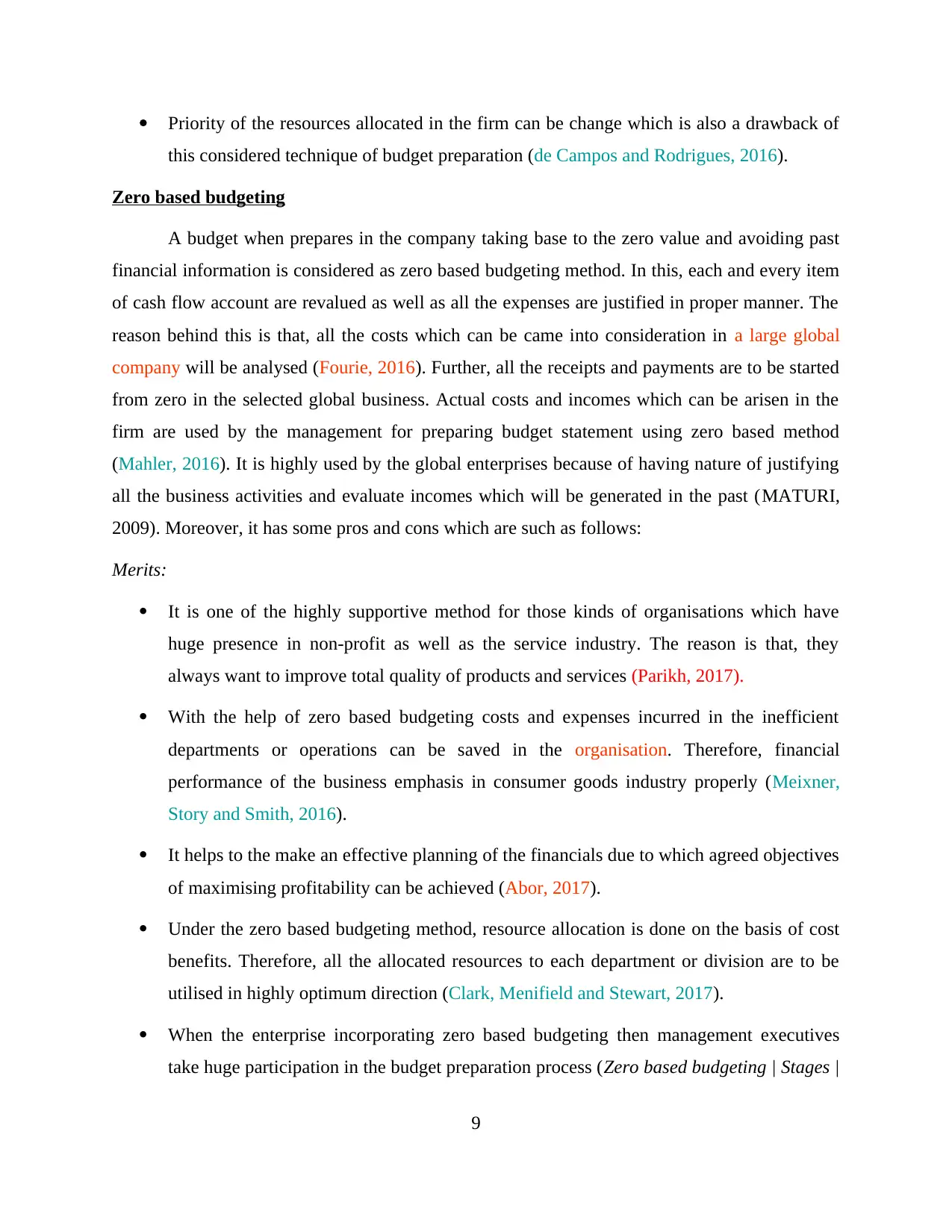
Priority of the resources allocated in the firm can be change which is also a drawback of
this considered technique of budget preparation (de Campos and Rodrigues, 2016).
Zero based budgeting
A budget when prepares in the company taking base to the zero value and avoiding past
financial information is considered as zero based budgeting method. In this, each and every item
of cash flow account are revalued as well as all the expenses are justified in proper manner. The
reason behind this is that, all the costs which can be came into consideration in a large global
company will be analysed (Fourie, 2016). Further, all the receipts and payments are to be started
from zero in the selected global business. Actual costs and incomes which can be arisen in the
firm are used by the management for preparing budget statement using zero based method
(Mahler, 2016). It is highly used by the global enterprises because of having nature of justifying
all the business activities and evaluate incomes which will be generated in the past (MATURI,
2009). Moreover, it has some pros and cons which are such as follows:
Merits:
It is one of the highly supportive method for those kinds of organisations which have
huge presence in non-profit as well as the service industry. The reason is that, they
always want to improve total quality of products and services (Parikh, 2017).
With the help of zero based budgeting costs and expenses incurred in the inefficient
departments or operations can be saved in the organisation. Therefore, financial
performance of the business emphasis in consumer goods industry properly (Meixner,
Story and Smith, 2016).
It helps to the make an effective planning of the financials due to which agreed objectives
of maximising profitability can be achieved (Abor, 2017).
Under the zero based budgeting method, resource allocation is done on the basis of cost
benefits. Therefore, all the allocated resources to each department or division are to be
utilised in highly optimum direction (Clark, Menifield and Stewart, 2017).
When the enterprise incorporating zero based budgeting then management executives
take huge participation in the budget preparation process (Zero based budgeting | Stages |
9
this considered technique of budget preparation (de Campos and Rodrigues, 2016).
Zero based budgeting
A budget when prepares in the company taking base to the zero value and avoiding past
financial information is considered as zero based budgeting method. In this, each and every item
of cash flow account are revalued as well as all the expenses are justified in proper manner. The
reason behind this is that, all the costs which can be came into consideration in a large global
company will be analysed (Fourie, 2016). Further, all the receipts and payments are to be started
from zero in the selected global business. Actual costs and incomes which can be arisen in the
firm are used by the management for preparing budget statement using zero based method
(Mahler, 2016). It is highly used by the global enterprises because of having nature of justifying
all the business activities and evaluate incomes which will be generated in the past (MATURI,
2009). Moreover, it has some pros and cons which are such as follows:
Merits:
It is one of the highly supportive method for those kinds of organisations which have
huge presence in non-profit as well as the service industry. The reason is that, they
always want to improve total quality of products and services (Parikh, 2017).
With the help of zero based budgeting costs and expenses incurred in the inefficient
departments or operations can be saved in the organisation. Therefore, financial
performance of the business emphasis in consumer goods industry properly (Meixner,
Story and Smith, 2016).
It helps to the make an effective planning of the financials due to which agreed objectives
of maximising profitability can be achieved (Abor, 2017).
Under the zero based budgeting method, resource allocation is done on the basis of cost
benefits. Therefore, all the allocated resources to each department or division are to be
utilised in highly optimum direction (Clark, Menifield and Stewart, 2017).
When the enterprise incorporating zero based budgeting then management executives
take huge participation in the budget preparation process (Zero based budgeting | Stages |
9
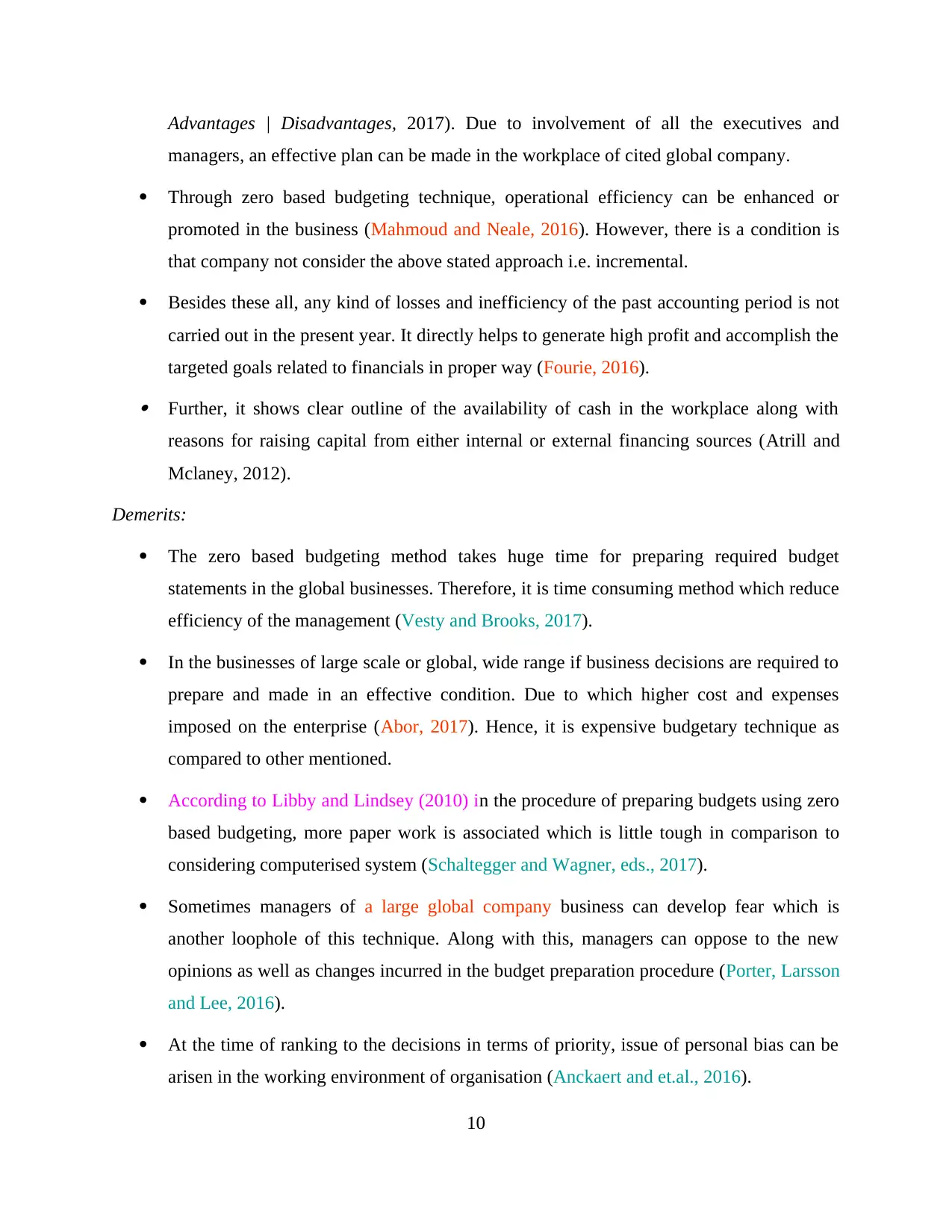
Advantages | Disadvantages, 2017). Due to involvement of all the executives and
managers, an effective plan can be made in the workplace of cited global company.
Through zero based budgeting technique, operational efficiency can be enhanced or
promoted in the business (Mahmoud and Neale, 2016). However, there is a condition is
that company not consider the above stated approach i.e. incremental.
Besides these all, any kind of losses and inefficiency of the past accounting period is not
carried out in the present year. It directly helps to generate high profit and accomplish the
targeted goals related to financials in proper way (Fourie, 2016). Further, it shows clear outline of the availability of cash in the workplace along with
reasons for raising capital from either internal or external financing sources (Atrill and
Mclaney, 2012).
Demerits:
The zero based budgeting method takes huge time for preparing required budget
statements in the global businesses. Therefore, it is time consuming method which reduce
efficiency of the management (Vesty and Brooks, 2017).
In the businesses of large scale or global, wide range if business decisions are required to
prepare and made in an effective condition. Due to which higher cost and expenses
imposed on the enterprise (Abor, 2017). Hence, it is expensive budgetary technique as
compared to other mentioned.
According to Libby and Lindsey (2010) in the procedure of preparing budgets using zero
based budgeting, more paper work is associated which is little tough in comparison to
considering computerised system (Schaltegger and Wagner, eds., 2017).
Sometimes managers of a large global company business can develop fear which is
another loophole of this technique. Along with this, managers can oppose to the new
opinions as well as changes incurred in the budget preparation procedure (Porter, Larsson
and Lee, 2016).
At the time of ranking to the decisions in terms of priority, issue of personal bias can be
arisen in the working environment of organisation (Anckaert and et.al., 2016).
10
managers, an effective plan can be made in the workplace of cited global company.
Through zero based budgeting technique, operational efficiency can be enhanced or
promoted in the business (Mahmoud and Neale, 2016). However, there is a condition is
that company not consider the above stated approach i.e. incremental.
Besides these all, any kind of losses and inefficiency of the past accounting period is not
carried out in the present year. It directly helps to generate high profit and accomplish the
targeted goals related to financials in proper way (Fourie, 2016). Further, it shows clear outline of the availability of cash in the workplace along with
reasons for raising capital from either internal or external financing sources (Atrill and
Mclaney, 2012).
Demerits:
The zero based budgeting method takes huge time for preparing required budget
statements in the global businesses. Therefore, it is time consuming method which reduce
efficiency of the management (Vesty and Brooks, 2017).
In the businesses of large scale or global, wide range if business decisions are required to
prepare and made in an effective condition. Due to which higher cost and expenses
imposed on the enterprise (Abor, 2017). Hence, it is expensive budgetary technique as
compared to other mentioned.
According to Libby and Lindsey (2010) in the procedure of preparing budgets using zero
based budgeting, more paper work is associated which is little tough in comparison to
considering computerised system (Schaltegger and Wagner, eds., 2017).
Sometimes managers of a large global company business can develop fear which is
another loophole of this technique. Along with this, managers can oppose to the new
opinions as well as changes incurred in the budget preparation procedure (Porter, Larsson
and Lee, 2016).
At the time of ranking to the decisions in terms of priority, issue of personal bias can be
arisen in the working environment of organisation (Anckaert and et.al., 2016).
10
⊘ This is a preview!⊘
Do you want full access?
Subscribe today to unlock all pages.

Trusted by 1+ million students worldwide
1 out of 32
Related Documents
Your All-in-One AI-Powered Toolkit for Academic Success.
+13062052269
info@desklib.com
Available 24*7 on WhatsApp / Email
![[object Object]](/_next/static/media/star-bottom.7253800d.svg)
Unlock your academic potential
Copyright © 2020–2025 A2Z Services. All Rights Reserved. Developed and managed by ZUCOL.





